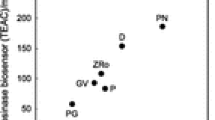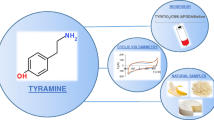Abstract
The catalytic oxidation of a synthetic water-soluble analogue of vitamin E (α-tocopherol, Trolox) by tyrosinase enzyme in the presence of molecular oxygen was studied using electrochemical techniques. This specific enzymatic reaction was exploited for the preparation of a biosensor based on the amperometric reduction of the electroactive product (α-tocoquinone) formed. An electroactive surface of the transducers used was covered with a thin conductive layer of Nafion containing tyrosinase. Significant progress in sensitivity towards polyphenolic compounds such as Trolox was achieved at CPE with carbon nanotubes immobilised on its surface (CPE/CNTs) as electric transducers. The biosensor so developed can be used for the direct determination of total phenolic content (TPC). This important nutrition value can be expressed as the mass equivalent of Trolox, i.e. Trolox equivalent antioxidant capacity (TEAC), which could be used as an alternative to the evaluations currently used based on spectrophotometric methods such as total radical-trapping antioxidant parameter (TRAP), ferric reducing-antioxidant power (FRAP) or 1,1-diphenyl-2-picrylhydrazyl spectrometric assay (DPPH). The effects of the enzyme amount in the Nafion layer (3.0 µg), the influence of the nanoparticles present, the optimal pH value suitable for enzymatic activity (7.0), and the kinetics of enzymatic and electrochemical reactions were studied using cyclic voltammetry (CV). The determination of optimal conditions for amperometry in batch configuration (working potential, speed of stirring, volume of sample, calibration curve, etc.) was not a target of this electrochemical study.
Similar content being viewed by others
References
Barisci, J. N., Wallace, G. G., & Baughman, R. H. (2000) Electrochemical characterization of single-walled carbon nanotube electrodes. Journal of the Electrochemical Society, 147, 4580–4583. DOI: 10.1149/1.1394104.
Brigelius-Flohé, R., & Traber, M. G. (1999) Vitamin E: function and metabolism. The FASEB Journal, 13, 1145–1155.
Cort, W. M., Vicente, T. S., Waysek, E. H., & Williams, B. D. (1983) Vitamin E content of feedstuffs determined by high-performance liquid chromatographic fluorescence. Journal of Agricultural and Food Chemistry, 31, 1330–1333. DOI: 10.1021/jf00120a045.
Giacomelli, C., Giacomelli, F. C., Alves, L. O., Timbola, A. K., & Spinelli, A. (2004) Electrochemistry of vitamin E hydroalcoholic solutions. Journal of the Brazilian Chemical Society, 15, 748–755. DOI: 10.1590/s0103-50532004000500022.
Golumbic, C., & Mattill, H. A. (1940) The oxidation of vitamin E. The Journal of Biological Chemistry, 134, 535–541.
Ismaya, W. T., Rozeboom, H. J., Weijn, A., Mes, J. J., Fusetti, F., Wichers, H. J., & Dijkstra, B. W. (2011) Crystal structure of Agaricus bisporus mushroom tyrosinase: Identity of the tetramer subunits and interaction with tropolone. Biochemistry, 50, 5477–5486. DOI: 10.1021/bi200395t.
Kalcher, K., Kaufmann, J. M., Wang, J., Svancara, I., Vytřas, K., Neuhold, C., & Yang, Z. (1995) Sensors based on carbon paste in electrochemical analysis: A review with particular emphasis on the period 1990–1993. Electroanalysis, 7, 5–22. DOI: 10.1002/elan.1140070103.
Kotzian, P., Brázdilová, P., Kalcher, K., & Vytřas, K. (2007) Mediators of electron transfer in amperometric enzyme biosensors. In K. Vytřas, & K. Kalcher (Eds.), Sensing in electroanalysis (Vol. 2, pp. 181–199). Pardubice, Czech Republic: University of Pardubice.
Laguerre, M., Lecomte, J., & Villeneuve, P. (2007) Evaluation of the ability of antioxidants to counteract lipid oxidation: Existing methods, new trends and challenges. Progress in Lipid Research, 46, 244–282. DOI: 10.1016/j.plipres.2007.05.002.
Mayer, A. M. (2006) Polyphenol oxidases in plants and fungi: Going places? A review. Phytochemistry, 67, 2318–2331. DOI: 10.1016/j.phytochem.2006.08.006.
Mikysek, T., Švancara, I., Kalcher, K., Bartoš, M., Vytřas, K., & Ludvík, J. (2009) New approaches to the characterization of carbon paste electrodes using the ohmic resistance effect and qualitative carbon paste indexes. Analytical Chemistry, 81, 6327–6333. DOI: 10.1021/ac9004937.
Moyad, M. A., Brumfield, S. K., & Pienta, K. J. (1999) Vitamin E, alpha and gamma tocopherol, and prostate cancer. Seminars in Urologic Oncology, 17, 85–90.
Núñez Delicado, E., Sánchez Ferrer, A., & García Carmona, F. (1997) A kinetic study of the one-electron oxidation of Trolox C by the hydroperoxidase activity of lipoxygenase. Biochimica et Biophysica Acta-General Subjects, 1335, 127–134. DOI: 10.1016/s0304-4165(96)00130-4.
Ozgen, M., Reese, R. N., Tulio, A. Z., Jr., Scheerens, J. C., & Miller, A. R. (2006) Modified 2,2-azino-bis-3-ethylbenzothiazoline-6-sulfonic acid (ABTS) method to measure antioxidant capacity of selected small fruits and comparison to ferric reducing antioxidant power (FRAP) and 2,2′-diphenyl-1-picrylhydrazyl (DPPH) methods. Journal of Agricultural and Food Chemistry, 54, 1151–1157. DOI: 10.1021/jf051960d.
Pedrosa, V. A., Codognoto, L., & Avaca, L. A. (2003) Electroanalytical determination of 4-nitrophenol by square wave voltammetry on diamond electrodes. Journal of the Brazilian Chemical Society, 14, 530–535. DOI: 10.1590/s0103-50532003000400007.
Pohanka, M., & Skládal, P. (2008) Electrochemical biosensors — principles and applications. Journal ofApplied Biomedicine, 6, 57–64.
Pourcel, L., Routaboul, J. M., Cheynier, V., Lepiniec, L., & Debeaujon, I. (2006) Flavonoid oxidation in plants: from biochemical properties to physiological functions. Trends in Plant Science, 12, 29–36. DOI: 10.1016/j.tplants.2006.11.006.
Scalbert, A., Johnson, I. T., & Saltmarsh, M. (2005) Polyphenols: antioxidants and beyond. The American Journal of Clinical Nutrition, 81, 215S–217S.
Simons, K., & Ikonen, E. (1997) Functional rafts in cell membranes. Nature, 387, 569–572. DOI: 10.1038/42408.
Solná, R., & Skládal, P. (2005) Amperometric flow-injection determination of phenolic compounds using a biosensor with immobilized laccase, peroxidase and tyrosinase. Electroanalysis, 17, 2137–2146. DOI: 10.1002/elan.200403343.
Sun, W., Jiang, Q., Yang, M., & Jiao, K. (2008) Electrochemical behaviors of hydroquinone on a carbon paste electrode with ionic liquid as binder. Bulletin of the Korean Chemical Society, 29, 915–920.
Sýs, M., Pekec, B., Kalcher, K., & Vytřas, K. (2013) Amperometric enzyme carbon paste-based biosensor for quantification of hydroquinone and polyphenolic antioxidant capacity. International Journal of Electrochemical Science, 8, 9030–9040.
Švancara, I., Vytřas, K., Barek, J., & Zima, J. (2001) Carbon paste electrode in modern electroanalysis. Critical Reviews in Analytical Chemistry, 31, 311–345. DOI: 10.1080/20014091076785.
Švancara, I., Metelka, R., & Vytřas, K. (2005) Piston driven carbon paste holders for electrochemical measurements. In K. Vytřas, & K. Kalcher (Eds.), Sensing in electroanalysis (pp. 7–18). Pardubice, Czech Republic: University of Pardubice.
Švancara, I., Kalcher, K., Walcarius, A., & Vytřas, K. (2012) Electroanalysis with carbon paste electrodes. Boca Raton, FL, USA: CRC Press.
Vytřas, K., Švancara, I., & Metelka, R. (2009) Carbon paste electrodes in electroanalytical chemistry. Journal of the Serbian Chemical Society, 74, 1021–1033. DOI: 10.2298/jsc0910021v.
Wang, J., Musameh, M., & Lin, Y. (2003) Solubilization of carbon nanotubes by Nafion toward the preparation of amperometric biosensors. Journal of the American Chemical Society, 125, 2408–2409. DOI: 10.1021/ja028951v.
Author information
Authors and Affiliations
Corresponding author
Rights and permissions
About this article
Cite this article
Sýs, M., Metelka, R., Mikysek, T. et al. Improvement of enzyme carbon paste-based biosensor using carbon nanotubes for determination of water-soluble analogue of vitamin E. Chem. Pap. 69, 150–157 (2015). https://doi.org/10.2478/s11696-014-0608-9
Received:
Revised:
Accepted:
Published:
Issue Date:
DOI: https://doi.org/10.2478/s11696-014-0608-9




